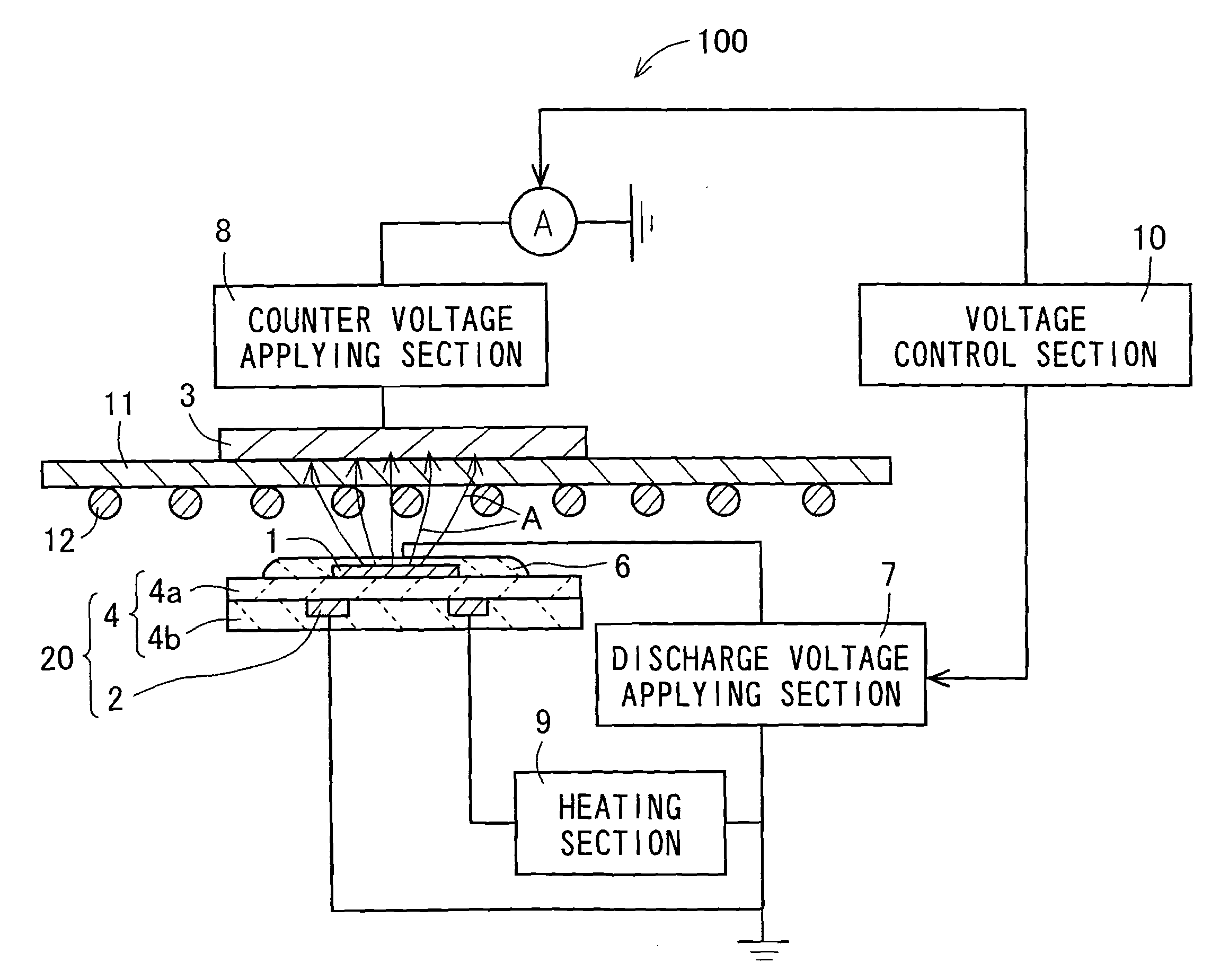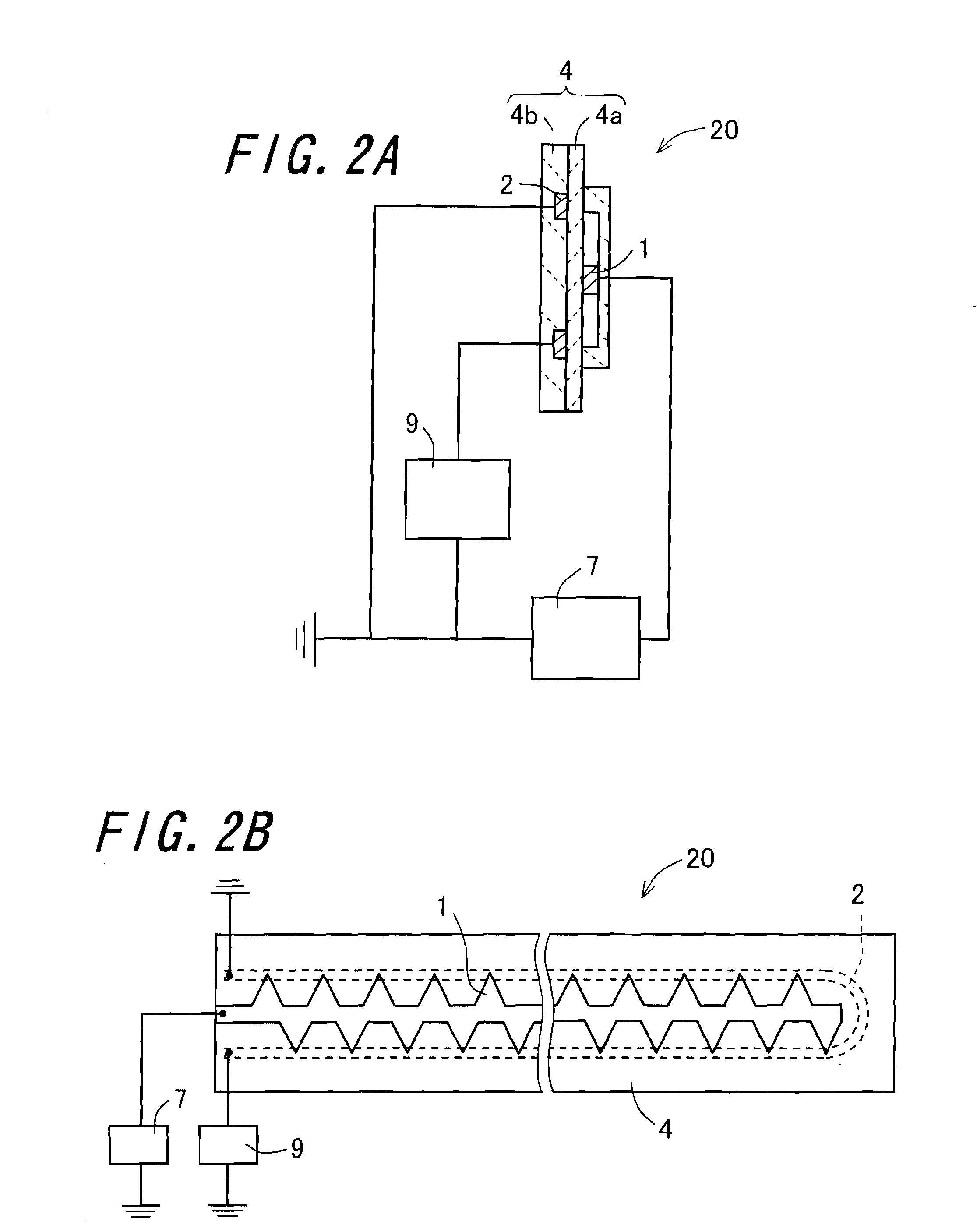Charging apparatus and image forming apparatus
- Summary
- Abstract
- Description
- Claims
- Application Information
AI Technical Summary
Benefits of technology
Problems solved by technology
Method used
Image
Examples
first embodiment
[0128]FIG. 1 is a view showing the constitution of a charging apparatus 100 in accordance with the invention. Moreover, FIGS. 2A and 2B are views showing the structure of an ion generating section 20. The charging apparatus 100 performs charging on a target object to be charged, namely a to-be-charged body 11. In a case where a toner image is formed on the to-be-charged body 11, toner 12 existing on the to-be-charged body 11 is subjected to charging. The charging apparatus 100 is composed of the ion generating section 20, a counter electrode 3, and a voltage control section 10.
[0129]The ion generating section 20 is a component to generate an ion for charging the to-be-charged body 11, and is composed of a dielectric body 4, a discharge electrode 1, an induction electrode 2, and a protective layer 6. The dielectric body 4 is constructed of a flat plate formed by bonding substantially rectangular-shaped upper and lower dielectrics 4a and 4b together. As a material for forming the diel...
second embodiment
[0143]FIG. 3A is a view showing the constitution of an image forming apparatus 200 in accordance with the invention. The image forming apparatus 200 is of a so-called tandem type and is also built as a printer that employs an intermediate transfer system to form a full-color image. The image forming apparatus 260 includes: a photoreceptor 31; a developing section 32; a transfer section 40; a fixing section 50; a photoreceptor cleaning section 33; a before-latent image-formation charging section 110; a before-intermediate-transfer charging section 120 acting as a first charging section; and a before-recording-transfer charging section 130 acting as a second charging section.
[0144]In order to deal with image data on different colors: cyan (C); magenta (M); yellow (Y); and black (K) included in color image data on an individual basis, the photoreceptor 31, a laser writing section (not shown in the figure), the developing section 32, the transfer section 40, the photoreceptor cleaning s...
third embodiment
[0158]FIG. 3B is a view showing the constitution of an image forming apparatus 210 in accordance with the invention. The image forming apparatus 210 is made the same as the image forming apparatus 200, except that, in the former, there is disposed a before-cleaning charging section 140 between the transfer section 40 and the photoreceptor cleaning section 33. The before-cleaning charging section 140, which acts as a third charging section, is constituted by the above-described charging apparatus 100. Herein, such constituent components as are common to those in the image forming apparatus 200 will be denoted by the same reference numerals and symbols, and overlapping descriptions will be omitted.
[0159]The before-cleaning charging section 140 is a component to charge toner left untransferred after the photoreceptor 31-transfer belt 41 transfer process, namely residual toner. In the before-cleaning charging section 140, a target object to be charged, namely a to-be-charged body is the...
PUM
 Login to view more
Login to view more Abstract
Description
Claims
Application Information
 Login to view more
Login to view more - R&D Engineer
- R&D Manager
- IP Professional
- Industry Leading Data Capabilities
- Powerful AI technology
- Patent DNA Extraction
Browse by: Latest US Patents, China's latest patents, Technical Efficacy Thesaurus, Application Domain, Technology Topic.
© 2024 PatSnap. All rights reserved.Legal|Privacy policy|Modern Slavery Act Transparency Statement|Sitemap



